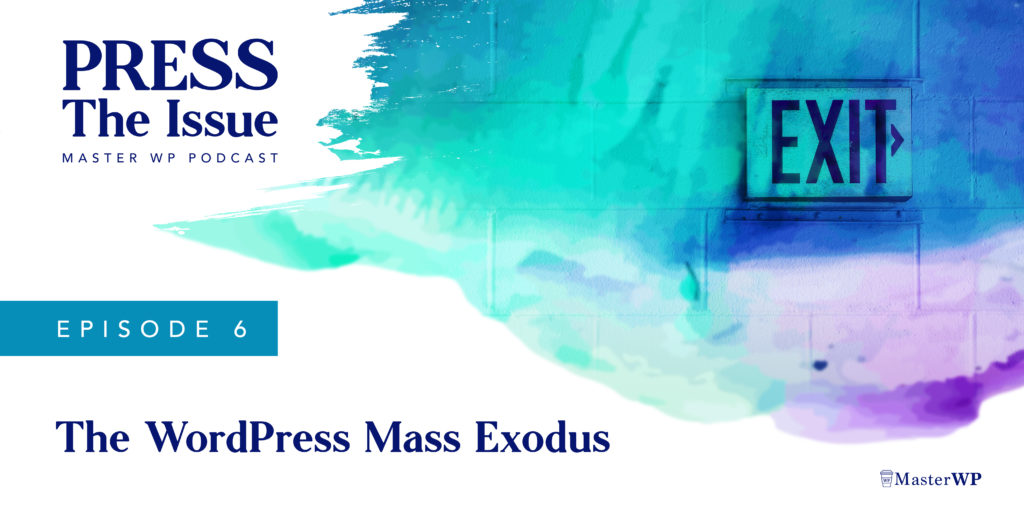Since the release of WordPress 6.0, there’s been a common refrain that many users feel that this latest release may be their last. It’s not a new feeling – saying you’ll leave WordPress is up there with saying you’ll quit social media, ditch dairy products, or head to Canada after the next U.S. election – but there has never been a more coherent argument for leaving. The general consensus from these voices is that progress around much of the core experience has been stagnant, that WordPress is trying to be too many things to too many people, or that the project is heading in a direction that doesn’t align with their professional needs.
I live in California, so I know a good mass exodus when I see one. While house-hunting this spring, almost every property we looked at was being sold by someone heading to Texas or Idaho. Multiple neighbors have left the state, and some family members have even threatened to leave as well (those threats having unfortunately been empty so far). This weekend the clerk at U-Haul told me that renting a truck heading out of California would cost eight to ten times the amount of driving one in. California is a zero-sum battle for natural resources and parking spaces, so we could shake a few hundred thousand people and I wouldn’t mind. Good riddance, I say – the aisles at my Trader Joe’s were feeling a little too tight anyway. WordPress, on the other hand, is a technology platform, and it should feel like it’s growing.
We’ll never really know if there’s a WordPress exodus happening, but there is a massive sense of unease around the project as a whole, and I see phrases like “turning points” and “crossroads” popping up like it’s WordPress 5.0 all over again. Let’s dive into it.
Is WordPress stagnant?
If you look at the stats compiled by Jean-Baptiste Audras for the 6.0 release, you’ll see an impressive array of contributions from around the globe, including a massive number of companies who gave back via Five for the Future. And yet, as I’ve pointed out, these contributions are almost entirely within one (albeit massive) feature: full site editing. For any site not using that beta feature, the WordPress experience feels remarkably similar to what it felt like three or even five years ago. Perhaps the block editor feels a bit snappier and the deep-cut features more mature, but the rest of WordPress feels largely the same.
And yet the ecosystem itself feels different. After losing Jeff Chandler a while back, the WP Tavern also saw the departure of Justin Tadlock, who I consider an OG of WordPress blogging. Luckily they still have Sarah Gooding killing it, but many other industry publications are dealing with churn or slower rates of publication. Local meetups have struggled to get back into the swing of regular, in-person meetings.
Similarly, the Post Status acquisition tracker is showing the same post-pandemic slump that many industries are feeling, with April ’22 completely empty. Much of this has to do with the extreme jolt our industry got during the pandemic, so only time will tell if we’re just settling into a more sustainable trajectory.
WordPress is too big to say that the entire project is “stagnant.” The progress is being made, we just all have our own versions of what progress might mean. In fact, I’m often seeing just the opposite criticism: that FSE and the focus on React is too different, with the changes coming too fast, for many developers.
Is the WordPress target market too big?
Another common criticism is that WordPress itself is trying to hit too large of a target: new sites, old sites, legacy sites, headless sites, static sites, page builders, site builders, advanced developers, middle developers, junior developers, brand-new developers, React developers, bloggers, writers, podcasters, content creators of all shapes and sizes. I could go on.
Some have argued that it’s making WordPress feel more complicated or that the software can’t be all things to all people. And I generally agree. I think there’s two main user groups that WordPress needs to cater to: developers and end-users. I’ve made the case before the WordPress needs to return to its roots as a platform.
For developers, WordPress needs to continue making it easy to extend, from the legacy of hooks and filters, to the REST API and potentially new ways to interact with data. Third-party developers should be building the page builders, theme developers should be building the front-end content. Creating custom blocks shouldn’t require a local build process.
For end users, WordPress needs to modernize the UI, build a more consistent design language and Settings API, and make sure that each plugin doesn’t feel like a completely separate website in your backend. Make every screen as pleasurable and consistent as possible and deal with the spam.
We need to end the breaking changes in the block editor, something that’s possibly the result of a lack of product management. Some of us pine for the days of Steve Jobs and his hasty “some of our thoughts” letters he’d throw out every so often, not just demoing but actually sharing his thought process on big changes. Hopefully this weekend’s conference will give us an extended preview into Matt Mullenweg’s management inner workings.
Is WordPress the best choice for a development agency?
The clear priority for WordPress for the last few years has been site building. Site building in this situation means applying the principles of WYSIWYG/drag-and-drop editing to the entire website-building process. In theory, this is a killer feature. In practice, it’s going to take a decade or more to get us there, and the end result may not even make sense by then, considering we’re still not at a point of reliably generating responsive designs.
Alternative CMSs proposed by the community, such as Statamic, actually go further in the opposite direction. Building content with Statamic feels much more like using Pods or Advanced Custom Fields, a method many development agencies find more familiar and more easy and reliable for clients. It is less opinionated on data storage and makes version control a lot easier. And it incorporates modern package management based on Laravel. Basically, it’s meant for developers. Ghost is another platform that looks enticing, and of course Shopify is wooing a lot of e-commerce away.
If WordPress is going to continue bring website developers along, it will need to think about at least some of these features. The good news is that if you were happy with how you built sites on WordPress over the last decade, there’s really no reason not to continue doing things that way, assuming you’re not heavily reliant on plugins that will need updates or will be integrated into full site editing.
I’m not leaving WordPress
Leaving WordPress sounds harder to me than leaving California: saying goodbye to my friends and family, starting my life from scratch, figuring out where to purchase all my avocados. Even worse, it would feel like leaving a religion: you now have to adopt an entirely new framework for how to create the world around you. It doesn’t sound easy. And, as Chris Wiegman recently asked, What is There Besides WordPress?
For every Californian family that I know heading out, there are plenty sticking around or coming in. Sometimes a narrative is simply a narrative. For an industry-specific publication with the letters “WP” in the title, there’s no reason to jump ship anytime soon. Plus, “MasterGhost” just sounds like a username a twelve-year-old picked for playing Call of Duty. Instead, we’re looking for ways to support the community, even if sometimes that means offering our constructive criticism.
The truth is, I don’t use WordPress for the core software, I use it for the ecosystem. I use it for the community. I use it for the off-the-shelf solutions that give me 80% of what I need at 20% of the effort. I use it because I believe we can all be part of something bigger.



